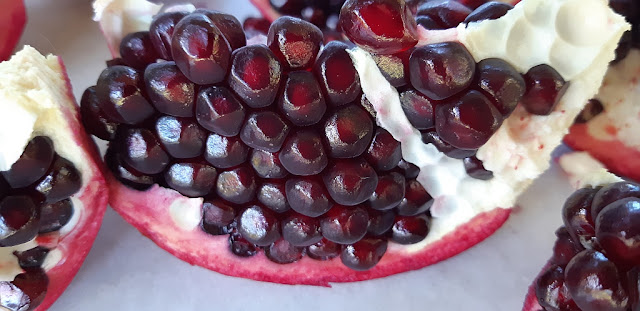When we planned the orchard, we planted fruit trees that would typically have been found in an old Cape country garden. The Pomegranate is a strong visual memory of the gardens of my youth. I can picture them vividly next to the “leidam”, beyond the apricot orchard next to my grandmother’s house in Barrydale. I also recall them along a “leivoor” at an uncle’s house in Prince Albert, and as a half-forgotten hedge at a sheep kraal in Calitzdorp.
I do not remember anybody using it for
anything else but eating as a fruit. I did not grow up with dishes being
prepared using pomegranate arils. No rich lamb stews with pomegranate,
pomegranate-braised pork belly, or orange and pomegranate cheesecake, to name a
few possibilities.
The closest I came to pomegranate juice was in the form of Roses grenadine. When we planted the pomegranate sapling tree in the orchard many years ago, it was simply for its cultural reference. Not as the exciting multi-purpose fruit we since discovered it to be. The tree never disappointed. We soon had more pomegranates than we could possibly eat.
It is a blessing that we can share the joy of this bright red fruit with friends, especially those that have had to exchange the farm for a retirement flat in town, or a room in the retirement home. I enjoy the fact that I can be the bearer of happy memories in the form of a basket of cheerful pomegranates. With each fruit leaving my basket for a bowl on such a table, another joyous memory is evoked that is guaranteed to crack a smile.
 |
| Cutting a pomegranate |
We still prefer to carry out this exercise under the shade of the oak in the garden. This limits the possibility of stray stains in the kitchen. As a further precaution I would suggest wearing dark clothes or an apron. Pomegranate stains can be challenging in the clean-up.
To squeeze out the juice I place the arils in a zip lock bag and squash out the juice with a rolling pin. When all the arils have been squashed, I cut a small hole in the one corner of the bag and allow the juice to decant without getting arils in the jug of juice.

Collecting arils under the oak tree is like an exercise in meditation. Spending time carefully removing each jewel like aril without breaking it is like therapy for the soul. When I came across the poem ‘How to cut a pomegranate’ by Imitiaz Dharker, I could relate to it in so many ways. The poem is rich with cultural history and symbolism.

How to cut a pomegranate by Imitiaz Dharker
‘Never,’ said my
father,
‘Never cut a
pomegranate
through the
heart. It will weep blood.
Treat it delicately,
with respect.
Just slit the
upper skin across four quarters.
This is a magic
fruit,
so when you split
it open, be prepared
for the jewels of
the world to tumble out,
more precious
than garnets,
more lustrous
than rubies,
lit as if from
inside.
Each jewel
contains a living seed.
Separate one
crystal.
Hold it up to
catch the light.
Inside is a whole
universe.
No common jewel
can give you this.’
Afterwards, I
tried to make necklaces
of pomegranate
seeds.
The juice spurted
out, bright crimson,
and stained my
fingers, then my mouth.
I didn’t mind.
The juice tasted of gardens
I had never seen,
voluptuous
with myrtle,
lemon, jasmine,
and alive with
parrots’ wings.
The pomegranate
reminded me
that somewhere I
had another home.










